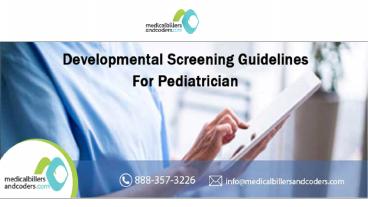Developmental Screening Guidelines for Pediatrician - PowerPoint PPT Presentation
Title:
Developmental Screening Guidelines for Pediatrician
Description:
In this article, we shared documentation guidelines that will help pediatricians on reporting developmental screening and testing services. – PowerPoint PPT presentation
Number of Views:15
Title: Developmental Screening Guidelines for Pediatrician
1
(No Transcript)
2
Developmental Screening Guidelines for
Pediatrician
Developmental screening, surveillance, and
assessment are often complemented by the use of
special tests, which vary in length. In this
article, we shared documentation guidelines that
will help pediatricians on reporting
developmental screening and testing
services. CPTs for Developmental Screening The
use of developmental screening instruments of a
limited nature is reported using CPT code 96110
(developmental testing limited). Code 96110 is
often reported when performed in the context of
preventive medicine services, but may also be
reported when screening is performed with
other evaluation and management (E/M)
services such as acute illness or follow-up
office visits. Extended developmental testing
using standardized instruments is reported using
CPT code 96111. This service may be reported
independently or in conjunction with another code
describing a separate patient encounter provided
on the same day as the testing (e.g., an
evaluation and management code for outpatient
consultation). A physician or other trained
professional typically performs this testing
service. Guidelines for Pediatrician
3
Developmental Screening Guidelines for
Pediatrician
Each administered developmental screening and the
testing instrument is accompanied by an
interpretation and report (e.g., a score or
designation as normal or abnormal). This is often
included in the test itself, but these elements
may alternatively be documented in the progress
report of the visit itself. Physicians are
encouraged to document any interventions based on
abnormal findings generated by the tests.
Following are examples of appropriate
documentation for some testing tools For CPT
96110 PEDS (Parents Evaluation of
Developmental Status) This questionnaire is
designed to identify any parent/primary
caretakers concerns about birth through an
eight-year childs developmental attainment and
behavioral/mental health concerns. There are
eight specific domain queries and one asking,
Please list any concerns about your childs
learning, development, and behavior and a final
please list any other concerns. The parent
answers are scored into the risk categories of
high, moderate, or low. The report form is
included with the test. ASQ (AGES AND STAGES
Questionnaire) This parent-report instrument,
covering ages 1 month through 60 months, includes
objective information as the adult notes whether
the child performs the skill identified.
4
Developmental Screening Guidelines for
Pediatrician
There are six questions in each of five domains
Communication, Gross Motor, Fine Motor, Problem
Solving, and Personal-Social. All questions are
scored on a point system, with summary scores
indicating the need for further evaluation. The
ASQ also has a nonspecific comprehensive section
where general concerns are addressed. No score is
provided for these answers, but the instrument
developers note any Yes responses should also
be referred. For CPT 96111 In general, the
documentation of developmental testing includes
the scoring, interpretation, and development of
the report. This typically includes all or some
of the following identifying data, time and
location of testing, the reason for the type of
testing being done, and the titles of all
instruments offered to/completed by the child
presence (if any) of additional persons during
testing, childs level of cooperation and
observations of childs behavior during the
testing session. Any assistive technology,
prosthetics, or modifications made to accommodate
the childs particular developmental or physical
needs should be described, and specific notations
should be made if any items offered resulted in a
change in the childs level of attention,
willingness to participate, the apparent ease of
task accomplishment.
5
Developmental Screening Guidelines for
Pediatrician
The item results should be scored and the test
protocol and any/all scoring sheets should be
included in the medical chart (computer scanning
may be needed for electronic medical records). A
brief interpretation should be recorded and
notation should be made for further evaluation or
treatment of the patient or family. A legible
signature should also appear. Managing pediatric
billing is a complicated, demanding job. You can
give your faculty more patient focus time by
outsourcing your billing process. Outsource
pediatric medical billing to increase your
practice collection. To know more about our
pediatric billing and coding services, get in
touch with us!































